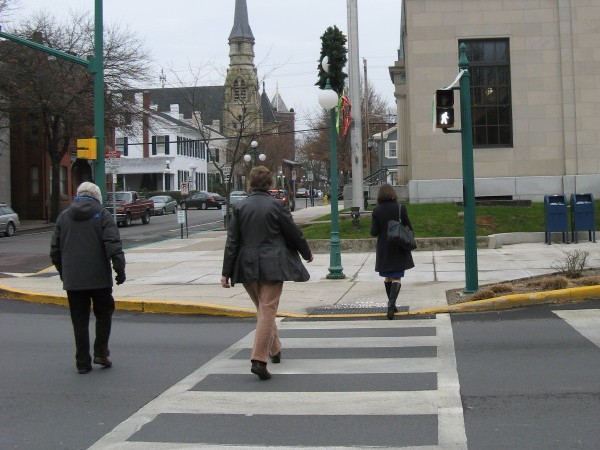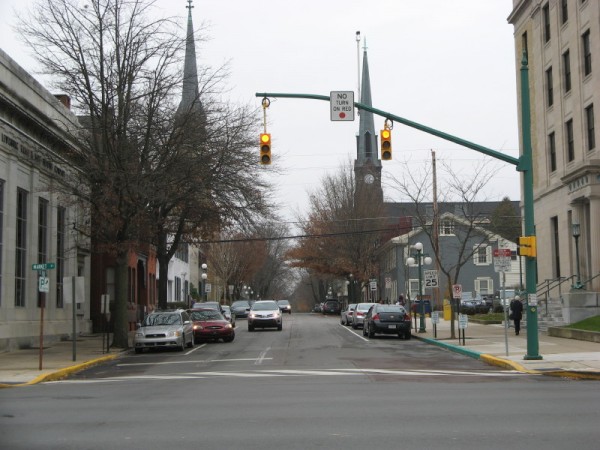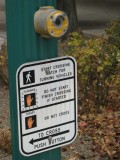What's the story with the pedestrian crossing lights on Market St? How do they work anyway?

This is something that baffles a lot of people. Many neighborhood residents cross Market on foot multiple times of day. Some have figured out the system of the lights through empirical observation. But the Lewisburg Borough Traffic Advisory Committee also has the inside track on how they function. While there's a lot of debate about how they ought to function, it's helpful to at least know how they are set right now.
Let's start with some history. At one time, there was a single central signal in the middle of the intersection, on a heavy masonry base. It almost made things look like a vestigial traffic circle. In more recent history, the bulb-outs, the extensions of the sidewalk on the north and south sides of Market St, were installed just a few years ago. They are part of a traffic calming and pedestrian safety effort which was put into motion by Professor Dick McGinnis, a former transportation engineering professor at Bucknell. Among other things, they succeeded in shortening the crossing distance significantly and enhancing visibility for pedestrians.
The all-way stop signal arrangement is the result of a specific request to PennDOT on the part of the Borough, in recognition of the needs of elderly residents from Heritage House living in close proximity to Market St. In general, the all-way stop is much safer for the very young and the very old. Planners sometimes refer to this as the 8-80 rule, asking whether those younger than 8 and older than 80 are served by a design.
One alternative would be a "walk with green" arrangement, in which the pedestrian going in a given direction gets a walk signal during the same part of the cycle that vehicular traffic has the green in that direction. During that same period, vehicles and pedestrians going the other way have a stop. This system can result in conflicts between pedestrians and turning traffic and is significantly harder for less able-bodied or alert pedestrians to navigate safely. One way to reduce those conflicts is to give an "advance walk" which lets the pedestrians enter the crosswalk a few seconds before the corresponding vehicular green light goes on. Most "walk with green" signals operate with every signal cycle, rather than being on demand.
 Why can't we just have the "walk with green" in effect for every signal and only get the all stop on request? Unfortunately it's forbidden in the Pennsylvania Vehicle Code. Confusingly, some aspects of the code do not apply to Philadelphia and Pittsburgh, which is why you can find a variety of programs in those locations (such as red light cameras) which are not legal in other parts of the state. We can either have "walk with green" or the "all stop," also known as a Barnes Dance.
Why can't we just have the "walk with green" in effect for every signal and only get the all stop on request? Unfortunately it's forbidden in the Pennsylvania Vehicle Code. Confusingly, some aspects of the code do not apply to Philadelphia and Pittsburgh, which is why you can find a variety of programs in those locations (such as red light cameras) which are not legal in other parts of the state. We can either have "walk with green" or the "all stop," also known as a Barnes Dance.
Independent of all that background, it does help to understand how the pedestrian lights are currently programmed and at least in theory be able to make informed decisions about how to negotiate the intersection. Transportation engineers recognize that pedestrians who know what to expect at an intersection are more likely to comply with signals. This is called managing expectations. Some urban areas use count-down signals, but in the absence of such expensive hardware, a clear understanding of the signal pattern helps.
The three traffic lights in the center of downtown Lewisburg cycle through three phases:
- The Market Street Phase -- Traffic travelling on Market Street has a green light. This phase lasts 22, 30, or 40 seconds depending on the time of day.
- The Optional Pedestrian Phase -- This 20 second phase is activated when a pedestrian presses the crosswalk button. Traffic is stopped all four ways. If a pedestrian does not push the crosswalk button more than 5 seconds before this phase begins, the Market Street Phase is extended by 20 seconds and the all stop does not occur until the next full cycle.
- The Cross Street Phase — Traffic traveling on the street crossing Market Street has a green light. This phase is activated only if a camera sensor mounted on the light stanchion detects traffic stopped at the light. It lasts from 28 to 35 seconds, depending on the time of day.
Late night operations aside, when Market just stays green indefinitely, the daytime total cycle length ranges from 70 seconds (with no cars on the cross street) to 90 seconds. No matter when you press the crosswalk button, you can only get a walk signal after the Market Street Phase, never after the Cross Street Green. If you push the button during the last 5 seconds of the Market Street Phase, you can find yourself waiting from 1 to 1 1/2 minutes for the walk signal, depending on side street traffic and time of day. This explains why drivers frequently remain stopped at all four intersections with no pedestrians in sight. Those pressing the crosswalk button only to wait a minute or more frequently cross without the walk signal rather than continue waiting.
Understanding this, however, you may be able to evaluate the situation as you approach the intersection and decide whether it makes sense to press the button and wait for the requested all stop or to walk with green. Some people do this depending on whether they are walking with children at a given time or after seeing how much traffic there is on Market.
While the light at 7th St is supposed to run the same way, for no apparent reason the pedestrian phase is after the cross street phase instead of after the Market St phase.
Changes to this system will require commissioning a formal traffic study, which the borough is considering, but there are costs associated with it. Adjusting the signal settings incurs an additional cost as well.
 Signage indicating how the lights operate has been proposed, but is not legal according to PennDOT, beyond the limited information already posted.
Signage indicating how the lights operate has been proposed, but is not legal according to PennDOT, beyond the limited information already posted.
On a related, but distinct topic, drivers also seem to suffer from uncertainty at these intersections. Pedestrians should note that when traffic is moving continuously but slowly, vehicles on Market St can legally enter the intersection on a yellow and yet not have crossed the far crosswalk before the walk light comes on. Please be alert when entering from the curb into the near travel lane (specifically northbound in front of the bank and southbound in front of the pharmacy). Additionally, some drivers stopped on a cross street, unaware that all stop is one of the signal options, proceed through the intersection as soon as the Market St light is red, presumably on the assumption that their signal must now be green, and oblivious to the fact that they are actually running a red light. This is not quite common enough to indicate an enforcement opportunity, but the Walk It Bike It committee would be glad to hear reports of incidents of these sorts.

